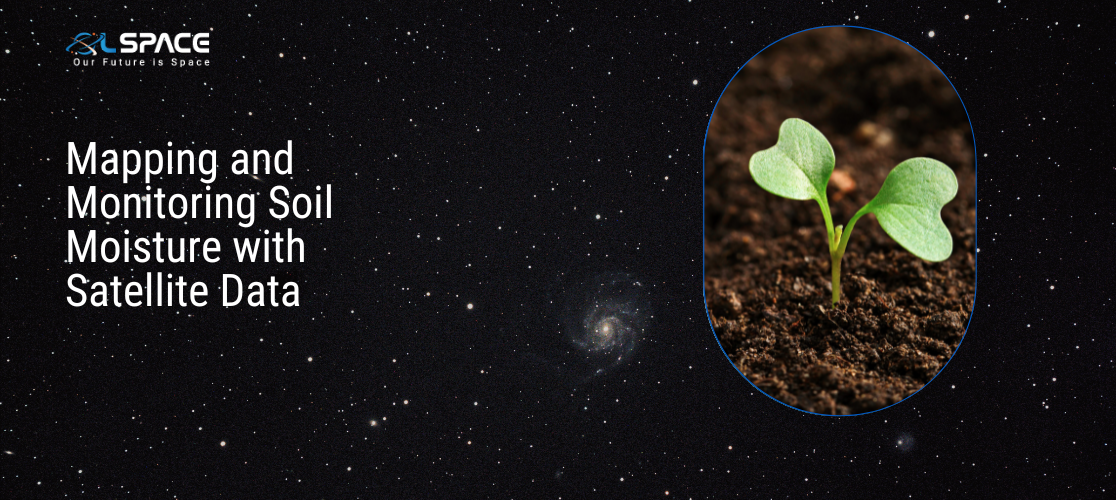20 June 2023
Mapping and Monitoring Soil Moisture with Satellite Data

Soil moisture is a critical factor in agriculture, hydrology, and environmental studies. It plays a crucial role in plant growth, water resource management, and weather patterns. Satellite data has revolutionised the mapping and monitoring of soil moisture, providing valuable insights into spatial and temporal variations. In this blog post, we will explore the importance of satellite data in mapping and monitoring soil moisture, its applications in various fields, and the benefits it brings to research, planning, and decision-making processes.
Remote Sensing of Soil Moisture: Satellite-based remote sensing allows for the estimation of soil moisture over large areas, providing valuable data on the water content in the top layer of soil. By measuring the electromagnetic radiation reflected or emitted by the Earth’s surface, satellite sensors can capture information related to soil moisture levels. This data is processed and analysed to generate spatially explicit maps of soil moisture content, enabling researchers and practitioners to monitor changes over time and across different regions.
Agricultural Applications: Accurate information on soil moisture is crucial for effective agricultural planning and management. Satellite-based soil moisture mapping helps farmers optimise irrigation practices, ensure proper water supply to crops, and prevent overwatering or water stress. By monitoring soil moisture levels in real-time, farmers can make informed decisions about irrigation scheduling, crop selection, and resource allocation, leading to improved water-use efficiency, increased crop yield, and reduced environmental impact.
Hydrological and Water Resource Management: Satellite data on soil moisture plays a vital role in hydrological modeling and water resource management. It provides insights into the water availability in watersheds, river basins, and catchment areas, helping hydrologists and water managers assess the potential for flooding, estimate runoff, and monitor drought conditions. Accurate soil moisture data assists in optimising reservoir operations, predicting water supply, and supporting water allocation decisions, ensuring the sustainable management of water resources.
Weather Forecasting and Climate Studies: Soil moisture significantly influences weather patterns and climate dynamics. Satellite-derived soil moisture data can improve weather forecasting models by providing information on the moisture content in the lower atmosphere. Changes in soil moisture affect evaporation rates, surface temperature, and the formation of clouds and precipitation. Integrating soil moisture data into weather and climate models enhances the accuracy of forecasts, particularly for regions prone to droughts or heavy rainfall events.
Environmental Monitoring and Ecosystem Studies: Satellite-based soil moisture monitoring supports environmental monitoring and ecosystem studies. It helps assess the health and resilience of ecosystems by providing information on soil moisture conditions, which directly influence vegetation growth, plant health, and habitat suitability. Soil moisture data aids in studying wetland ecosystems, estimating evapotranspiration rates, and monitoring soil moisture changes in areas prone to land degradation or desertification. This information contributes to informed decision-making for conservation efforts and ecosystem restoration projects.
Land Management and Disaster Risk Reduction: Accurate soil moisture information derived from satellite data assists in land management practices and disaster risk reduction. It helps identify areas at risk of soil erosion, landslides, or forest fires by detecting soil moisture anomalies and potential instabilities. This information enables land managers and emergency response agencies to implement preventive measures, such as erosion control, land reclamation, and early warning systems, reducing the vulnerability of communities to natural disasters.
Conclusion: Satellite data has revolutionised the mapping and monitoring of soil moisture, providing valuable insights into spatial and temporal variations. Applications in agriculture, hydrology, weather forecasting, environmental monitoring, and land management have demonstrated the significance of satellite-based soil moisture data. By leveraging this data, researchers, farmers, water managers, and policymakers can make informed decisions to optimise resource allocation, improve agricultural practices, manage water resources effectively, mitigate environmental risks, and enhance overall sustainability. The continuous advancements in satellite technology and data analysis techniques hold great potential for further advancements in soil moisture mapping and monitoring, supporting a wide range of disciplines and contributing to more informed and sustainable decision-making processes.
Join our community and never miss an update! Subscribe to our newsletter and blog to stay up-to-date on the latest trends, tips, and insights in your area of interest. Don’t miss out on exclusive content and promotions. Sign up now and be a part of our growing community!
